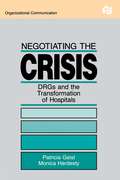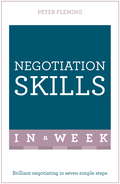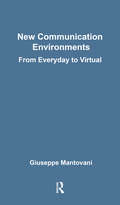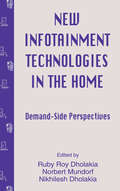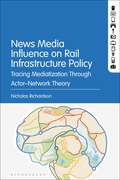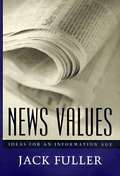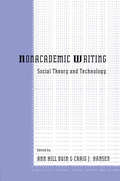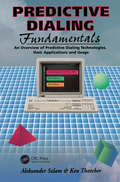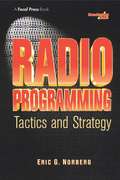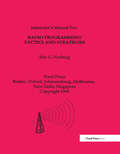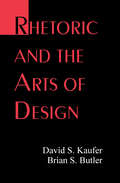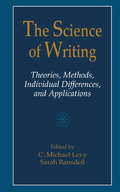- Table View
- List View
Negotiating the Crisis: Drgs and the Transformation of Hospitals (Routledge Communication Series)
by Patricia Geist Monica HardestyIn 1984 Congress revamped Medicare to save a financially distraught health care system, thus transforming the hospital as an organization. Diagnosis Related Groups (DRGs) -- the cornerstone of this extensive reorganization -- have triggered repercussions that are still adversely affecting health care professionals. This volume cuts to the heart of this crisis, examining the difficulties and foibles of going from DRG Legislation to DRG practices and giving voice to the professionals who must carve out a new reality under DRGs. It exposes the disputes between the various professional groups -- administrators, physicians, and nurses --over the implementation of DRGS, and how these professionals maneuver to manage the health service problems created by the policy. The book's authors provide an insightful analysis of the way policy innovations can wreak havoc on an organization and how professionals working together eventually negotiate order out of the chaos of change. The volume's narrative style of research is one feature that makes the presentation of the authors' findings unique from other works on Medicare legislation. Additionally, the book offers a case study approach to communication and sociological matters of a significant health care issue.
Negotiating the Crisis: Drgs and the Transformation of Hospitals (Routledge Communication Series)
by Patricia Geist Monica HardestyIn 1984 Congress revamped Medicare to save a financially distraught health care system, thus transforming the hospital as an organization. Diagnosis Related Groups (DRGs) -- the cornerstone of this extensive reorganization -- have triggered repercussions that are still adversely affecting health care professionals. This volume cuts to the heart of this crisis, examining the difficulties and foibles of going from DRG Legislation to DRG practices and giving voice to the professionals who must carve out a new reality under DRGs. It exposes the disputes between the various professional groups -- administrators, physicians, and nurses --over the implementation of DRGS, and how these professionals maneuver to manage the health service problems created by the policy. The book's authors provide an insightful analysis of the way policy innovations can wreak havoc on an organization and how professionals working together eventually negotiate order out of the chaos of change. The volume's narrative style of research is one feature that makes the presentation of the authors' findings unique from other works on Medicare legislation. Additionally, the book offers a case study approach to communication and sociological matters of a significant health care issue.
Negotiation Skills In A Week: Brilliant Negotiating In Seven Simple Steps (TYW)
by Peter FlemingEffective negotiation skills just got easierThere was a time, not that long ago, when negotiation was seen, in the main, as the province of industrial relations folk and car-sales advisers. But, no longer! Repeated financial crises have squeezed profit margins and, in some markets, discouraged buyers from making marginal purchases or continuing habitual expenditure. Managers have found themselves in the frontline of the expectation to achieve better value for money, and the starting point for this is to shop around and explore the offers made by new suppliers, and/or to negotiate better deals with existing suppliers.Even if your job doesn't involve negotiation, then you might still be an active negotiator when replacing your car, moving house or even selling last season's wardrobe! The truth is that being a good negotiator has become a life skill, enabling those who are good at it not just to save money, but also to upgrade their computer, television or lawnmower with little or no increase in outgoings - and enhancing their reputation in the process.Becoming an effective negotiator is certainly within the scope of the majority of people. At its simplest, it involves thinking out what you want, planning how you'd like to get it and developing your powers of persuasion to convince other people that you are simply being reasonable.This book will help you to plan to become a better negotiator through being better prepared for meetings, planning clear and realistic objectives for a negotiation, maintaining concentration and making logical proposals that create agreement in the other party.- Sunday: Creating the right environment- Monday: Researching your objectives - Tuesday: People and places - Wednesday: Breaking the ice - Thursday: The agenda - Friday: Concluding- Saturday: Learning from your experiences
New Communications Environments: From Everyday To Virtual
by Giuseppe MantovaniThis multi-disciplinary book develops three intertwined themes: the perspective of situated action from cognitive science, a model of social context as a framework for inspiring artifact use and starting from it, and the individual and organizational impact of the new electronic environments of communication. Using plenty of up-to-date references from different scientific disciplines such as HCI, computer-mediated communication, cognitive sciences, social psychology, cultural anthropology and research in decision making, the book challenges older models of communication as information transfer and discusses the new communication environments.
New Communications Environments: From Everyday To Virtual
by Giuseppe MantovaniThis multi-disciplinary book develops three intertwined themes: the perspective of situated action from cognitive science, a model of social context as a framework for inspiring artifact use and starting from it, and the individual and organizational impact of the new electronic environments of communication. Using plenty of up-to-date references from different scientific disciplines such as HCI, computer-mediated communication, cognitive sciences, social psychology, cultural anthropology and research in decision making, the book challenges older models of communication as information transfer and discusses the new communication environments.
New infotainment Technologies in the Home: Demand-side Perspectives (Routledge Communication Series)
by Ruby Roy Dholakia Norbert Mundorf Nikhilesh DholakiaAs the "information superhighway" moves into the home through interactive media, enhanced telecom services, and hybrid appliances, interest continually grows in how consumers adopt and use Information Technology (IT), the strategies IT marketers use to reach consumers, and the public policies that help and protect consumers. USE COPY FROM THIS POINT ON FOR GENERAL CATALOGS... This book presents a unique collection of papers dealing with the demand side issues of new information technologies in the home. The contributors are from business, academia, and the public policy sector and represent many disciplines including communication, marketing, economics, psychology, engineering, and information systems. This book provides one of the best introductions to complex issues such as: * business forces that will shape "Home IT" of the future; * industry structure of the future "Infotainment" mega-business; * factors affecting consumer adoption and use of IT; * international differences in the management of the IT sector; and * public policies that will shape the deployment and use of IT.
New infotainment Technologies in the Home: Demand-side Perspectives (Routledge Communication Series)
by Ruby Roy Dholakia Norbert Mundorf Nikhilesh DholakiaAs the "information superhighway" moves into the home through interactive media, enhanced telecom services, and hybrid appliances, interest continually grows in how consumers adopt and use Information Technology (IT), the strategies IT marketers use to reach consumers, and the public policies that help and protect consumers. USE COPY FROM THIS POINT ON FOR GENERAL CATALOGS... This book presents a unique collection of papers dealing with the demand side issues of new information technologies in the home. The contributors are from business, academia, and the public policy sector and represent many disciplines including communication, marketing, economics, psychology, engineering, and information systems. This book provides one of the best introductions to complex issues such as: * business forces that will shape "Home IT" of the future; * industry structure of the future "Infotainment" mega-business; * factors affecting consumer adoption and use of IT; * international differences in the management of the IT sector; and * public policies that will shape the deployment and use of IT.
News Media Influence on Rail Infrastructure Policy: Tracing Mediatization Through Actor–Network Theory
by Nicholas RichardsonIn this book, Richardson's research spans a decade and two cities - Sydney, Australia and Montreal, Canada - focusing on three metro-style rail infrastructure case study projects: one ongoing, one failed and one upgraded after reaching fifty years of age – to build an irrefutable case that the news media is highly influential to policy, and that these influences are complex, messy and changing.News Media Influence on Rail Infrastructure Policy offers scholars and industry practitioners in the arenas of policy analysis, politics and media communications a method for astutely guiding large-scale projects through the complex and changing landscape of 24/7 news media. It is underpinned by empirical research that identifies and endeavors to close a considerable gap in current understanding and practice. This gap represents a failure to recognise and respect mediatization – the many powerful influences impacting a policy arena that has drawn the ire of the news media. The result of this failure is ineffective communication that does little to advance the policy piece and, in the worst instances, leads to policy immobilisation or poor policy decision-making.Drawing significantly on Actor–Network Theory, Richardson identifies the influential actors and alliances at play when policy is subjected to media discourse, and he proposes a framework for tracing and managing them. In doing so, he demonstrates that such a framework is not only vital for the successful negotiation of policy and projects in the media, but also to an (r)evolutionary recasting of public, expert and media actors in the development and decision-making process.
News Values: Ideas for an Information Age
by Jack FullerNews Values is a concise, powerful statement of the fundamental issues, ethical and practical, confronting newspapers today. Jack Fuller not only makes those issues clear, but offers a provocative new perspective on questions journalists should be asking themselves now in order to prepare for tomorrow. "Every talk show host should read this book. So should every newsroom cynic. . . . 'Pursuit of truth is not a license to be a jerk.' In all too many newsrooms, that statement would resound like a three-bell bulletin."—Martin F. Nolan, New York Times Book Review "[News Values] ought to be required reading not just for those who work for newspapers, but for all those who read and care about them. . . . [This book] seems destined to become one of those slim but important volumes people read for a long time to come."—Richard J. Tofel, Wall Street Journal "Fuller stays above the fray [of the many books on the media]: His is a deeply intellectual approach, one that provides serious context to the highly complicated issue of how the news 'works.'"—Duncan McDonald, Chicago Tribune Books "News Values has the touch and feel of knowledgeable, authentic caring about the kind of journalism than can help make society more cohesive, even human." —"Monitor's Pick," Christian Science Monitor
Nonacademic Writing: Social Theory and Technology
by Ann Hill Duin Craig J. HansenIn this volume, methodological, cultural, technological, and political boundaries felt by writers are analyzed, translated, and challenged in a way that will appeal to researchers, theorists, graduate students, instructors, and managerial audiences. Instead of extracting rules from previous research, the contributors, working from multidisciplinary perspectives, describe and analyze the social and technological contexts surrounding nonacademic writing. Their essays present a formative rather than summative outlook toward future research on nonacademic writing. Collectively, these chapters articulate a unique perspective toward nonacademic writing that considers: * The centrality of emerging communications technologies in nonacademic writing research and the need for a socio-technological perspective. New technologies reshape the concept of text and significantly impact the writing process and written products in nonacademic settings. * The relationship between the academy and the workplace. A number of chapters challenge us -- sometimes from opposing perspectives -- to scrutinize our role as writing educators in preparing students for the workplace. Should we support the interests of corporate employers, or should we resist those interests? Should we enculturate students in workplace writing practices by placing them in these environments, or should we examine the tacit knowledge gained by workplace professionals and deliver this via classroom instruction? * New theory, new research agendas. Contributors from diverse fields offer new theoretical lenses or use established lenses in innovative ways, expanding the agenda for nonacademic writing research. This volume represents the vision the social landscape demands for research and pedagogy in nonacademic writing.
Nonacademic Writing: Social Theory and Technology
by Ann Hill DuinIn this volume, methodological, cultural, technological, and political boundaries felt by writers are analyzed, translated, and challenged in a way that will appeal to researchers, theorists, graduate students, instructors, and managerial audiences. Instead of extracting rules from previous research, the contributors, working from multidisciplinary perspectives, describe and analyze the social and technological contexts surrounding nonacademic writing. Their essays present a formative rather than summative outlook toward future research on nonacademic writing. Collectively, these chapters articulate a unique perspective toward nonacademic writing that considers: * The centrality of emerging communications technologies in nonacademic writing research and the need for a socio-technological perspective. New technologies reshape the concept of text and significantly impact the writing process and written products in nonacademic settings. * The relationship between the academy and the workplace. A number of chapters challenge us -- sometimes from opposing perspectives -- to scrutinize our role as writing educators in preparing students for the workplace. Should we support the interests of corporate employers, or should we resist those interests? Should we enculturate students in workplace writing practices by placing them in these environments, or should we examine the tacit knowledge gained by workplace professionals and deliver this via classroom instruction? * New theory, new research agendas. Contributors from diverse fields offer new theoretical lenses or use established lenses in innovative ways, expanding the agenda for nonacademic writing research. This volume represents the vision the social landscape demands for research and pedagogy in nonacademic writing.
Ökologieorientierte Führung multinationaler Unternehmen in Entwicklungsländern
by Walter StöcklAufgrund der bedrohlichen ökologischen Situation, eines steigenden Problembewußtseins sowie internationaler politischer Einflüsse wird der Umweltschutz zunehmend auch in Entwicklungsländern zu einem wesentlichen Faktor der wirtschaftlichen Rahmenbedingungen.
Opposing Ambitions: Gender and Identity in an Alternative Organization
by Sherryl Kleinman"Renewal" is a holistic health center run by baby boomers whose political ideals were shaped by the counterculture movements of the 1960s. Through interviews and observation, Sherryl Kleinman takes us inside Renewal and shows us how its members struggled to maintain a view of themselves as progressive and alternative even as they sought conventional legitimacy. In Opposing Ambitions we meet the members of Renewal as individuals; learn about the differences in power, prestige, and respect they are accorded; why they talked endlessly about money; and how they related to each other. Kleinman shows how members' attempts to see themselves as unconventional, but also as serious operators of a legitimate health care organization, led them to act in ways that undermined their egalitarian goals. She draws out the lessons Renewal offers for understanding the problems women face in organizations, the failure of social movements to live up to their ideals, and how it is possible for progressives to avoid reproducing the inequalities they claim to oppose.
People and Computers XI: Proceedings of HCI’96
by Angela Sasse Jim Cunningham Russel WinderDisciplines, including Human-Computer Interaction (HCI), consist of knowledge supporting practices which solve general problems (Long & Dowell, 1989). A disci pline thus requires knowledge to be acquired which can be applied by practitioners to solve problems within the scope of the discipline. In the case of HCI, such knowledge is being acquired through research and, less formally, through the description of successful system development practice. Some have argued that knowledge is further embodied in the artefacts. HCI knowledge is applied to solve user interface design problems. Such applica tion is facilitated if the knowledge is expressed in a conception which makes explicit the design problems of practitioners. A conception has been proposed by Dowell & Long (1989). The conception provides a framework within which to reason about the implications of designs for system performance. The framework is concordant with the trend towards design, discernible in recent HCI research. It is further compatible with notions of top-down design, fundamental to software engineering practice. 2 Teaching and the HeI Research and Development Gap 2.1 An Assessment of Current HCI Education Teaching is one means by which practitioners learn to specify discipline problems. It is also a means by which they acquire knowledge to enable the problems to be solved.
Performance Engineering of Computer and Telecommunications Systems: Proceedings of UKPEW’95, Liverpool John Moores University, UK. 5 – 6 September 1995
by Madjid Merabti Michael Carew Frank BallThis book is the proceedings of the Workshop on the Performance Engineering of Computer and Telecommunications Systems. The workshop Was held at Liverpool John Moores University, England on the 5th and 6th September 1995. The workshop follows a series organised by the British Computer Society (BCS) Special Interest Group on Performance Engineering. The workshop addressed most techniques and experieI1ces in the Engineering of Computer and Telecommunications Systems that provide a guaranteed quality of service. Techniques such as measurements, simulation, and analytical models and their applications to ATM networks, Multimedia Systems, Distributed Systems, Access and Wide Area Networks were presented. In addition a number of papers dealt with advances in the development of analytical models, simulation architectures and the application of formal methods, stich as Process Algebra, to the specification and building of performance biased computer systems. The book is suitable for systems designers, engineers, researchers and postgraduate students interested in the design and implementation of Computer Systems, Networks and Telecommunications. Many people assisted in the arrangements and success of this workshop. I would like to thank them all and in particular the reviewers. I would also like to particularly thank our industrial sponsors GPT Public Networks Group, Liverpool and BICC Cables, Chester, England for their generous financial and material support.
Predictive Dialing Fundamentals: An Overview of Predictive Dialing Technologies, Their Applications, and Usage Today
by Aleksander Szlam Ken ThatcherWho should read this book? This is a must read if you're a newcomer to predictive dialers and responsible for analyzing, recommending and deploying inbound and outbound call center solutions; or, if you're in the midst of implementing a predictive dialer,
Processing interclausal Relationships: Studies in the Production and Comprehension of Text
by Jean Costermans Michel FayolDuring the last 10 years, more and more linguistic and psycholinguistic research has been devoted to the study of discourse and written texts. Much of this research deals with the markers that underline the connections and the breaks between clauses and sentences plus the use of these markers -- by adults and children -- in the production and comprehension of oral and written material. In this volume, major observations and theoretical views from both sides of the Atlantic are brought together to appeal to a wide range of linguists, psychologists, and speech therapists. The volume presents contributions from researchers interested specifically in adult language and from others concerned with developmental aspects of language. Some contributors deal primarily with production, whereas others concentrate on comprehension. Some direct their attention to oral discourse while others focus on written texts. To preserve overall coherence, however, the contributors were given the following recommendations: * With regard to the level of linguistic analysis, the emphasis should be on the clause level -- more particularly, on the relationships between clauses. * Special emphasis should also be placed on linguistic markers (e.g., connectives, markers of segmentation, punctuation). * An overview of a given field of research should be offered, and current research should be put into perspective. * For contributors in the developmental field, attention should be paid to the fact that an account of the acquisition of some language functions throughout childhood should be included only if general principles of interclause relations that might be masked by the exclusive examination of adult evidence could be derived from it.
Processing interclausal Relationships: Studies in the Production and Comprehension of Text
by Jean Costermans Michel FayolDuring the last 10 years, more and more linguistic and psycholinguistic research has been devoted to the study of discourse and written texts. Much of this research deals with the markers that underline the connections and the breaks between clauses and sentences plus the use of these markers -- by adults and children -- in the production and comprehension of oral and written material. In this volume, major observations and theoretical views from both sides of the Atlantic are brought together to appeal to a wide range of linguists, psychologists, and speech therapists. The volume presents contributions from researchers interested specifically in adult language and from others concerned with developmental aspects of language. Some contributors deal primarily with production, whereas others concentrate on comprehension. Some direct their attention to oral discourse while others focus on written texts. To preserve overall coherence, however, the contributors were given the following recommendations: * With regard to the level of linguistic analysis, the emphasis should be on the clause level -- more particularly, on the relationships between clauses. * Special emphasis should also be placed on linguistic markers (e.g., connectives, markers of segmentation, punctuation). * An overview of a given field of research should be offered, and current research should be put into perspective. * For contributors in the developmental field, attention should be paid to the fact that an account of the acquisition of some language functions throughout childhood should be included only if general principles of interclause relations that might be masked by the exclusive examination of adult evidence could be derived from it.
Radio Programming: Tactics And Strategy (Broadcasting And Cable Ser.)
by Eric NorbergA practical handbook for programming directors, this guide focuses on achieving specific objectives in today's modern, competitive environment. Radio Programming is designed to convey underlying principles and to assist the programmer in accomplishing specific objectives, without mandating exact implementation methods. Instead, it empowers station management and the PD to implement strategies that will work for the particular format and market niche. Radio Programming will be helpful for neophytes in programming, experienced programmers seeking further growth, air talent seeking to develop skills, and general managers trying to understand programming and effectively manage program directors without stifling creativity. It will also help general managers hire effective programmers.Eric Norberg is the editor and publisher of the Adult Contemporary Music Research Letter and a radio consultant. He has worked as a program director at several radio stations, as on-air talent and general manager, and has also operated a radio production company. For fourteen years he has written a weekly column on radio programming for The Gavin Report, a radio trade publication.
Radio Programming Tactics and Strategies
by NorbertFirst published in 2002. Routledge is an imprint of Taylor & Francis, an informa company.
Radio Programming Tactics and Strategies
by NorbertFirst published in 2002. Routledge is an imprint of Taylor & Francis, an informa company.
Radio Programming: Tactics and Strategy
by Eric NorbergA practical handbook for programming directors, this guide focuses on achieving specific objectives in today's modern, competitive environment. Radio Programming is designed to convey underlying principles and to assist the programmer in accomplishing specific objectives, without mandating exact implementation methods. Instead, it empowers station management and the PD to implement strategies that will work for the particular format and market niche. Radio Programming will be helpful for neophytes in programming, experienced programmers seeking further growth, air talent seeking to develop skills, and general managers trying to understand programming and effectively manage program directors without stifling creativity. It will also help general managers hire effective programmers.Eric Norberg is the editor and publisher of the Adult Contemporary Music Research Letter and a radio consultant. He has worked as a program director at several radio stations, as on-air talent and general manager, and has also operated a radio production company. For fourteen years he has written a weekly column on radio programming for The Gavin Report, a radio trade publication.
Rhetoric and the Arts of Design
by David S. Kaufer Brian S. ButlerThe design arts -- from the design of buildings and machines to software and interfaces -- are associated with types of knowledge and performance thought to be structured, modular, and systematic. Such arts have become increasingly prestigious in our technocratic society. Since Aristotle, the art of rhetoric was conceived as a loosely structured "practical" art thought to be limited in the extent to which it could mimic more precise subject matters. The art of rhetoric has been controversial since classical times, but its status has sunk even lower since the industrial revolution -- a point when civic cultures began to cede authority and control to the cultures of specialized experts. Many sympathizers of rhetoric have resisted its decline by calling for a civic art of public discourse to stand in opposition to a technocratic specialized discourse that has come, increasingly, to disenfranchise the ordinary citizen. This is the first book to question the rhetoric/technical knowledge split from a more fundamental perspective. To get some perspective on what is at stake in rhetoric's traditional classification as a "practical" art, the authors: * explore the distinction between practical and design arts; * enumerate the various criteria cited in the literature for qualifying a cluster of knowledge and performative skills to count as an art of design; * show how the knowledge and performative skills associated with the art of rhetoric meet the major requirements of design knowledge; * propose a general architecture of rhetorical design, one descriptive both of civic address and specialized academic argument; * turn to the Lincoln/Douglas debates to embody and provide some empirical support and illustration for their architecture; * demonstrate how Lincoln and Douglas can be thought of as expert designers whose rhetoric is highly structured and modular; and * explain how the rhetoric of both rhetorical agents can be represented in the layers and modules that one needs to display plans for buildings, software, or other design artifacts. These layers and modules are not just post hoc annotations of the debates; they also illuminate new and systematic ways for viewing the debates -- and by implication, other specimens of rhetoric -- in terms of strategies of artistic production. Kaufer and Butler conclude their presentation by citing some of the research and educational implications that follow from housing rhetoric within the family of design arts.
Rhetoric and the Arts of Design
by David S. Kaufer Brian S. ButlerThe design arts -- from the design of buildings and machines to software and interfaces -- are associated with types of knowledge and performance thought to be structured, modular, and systematic. Such arts have become increasingly prestigious in our technocratic society. Since Aristotle, the art of rhetoric was conceived as a loosely structured "practical" art thought to be limited in the extent to which it could mimic more precise subject matters. The art of rhetoric has been controversial since classical times, but its status has sunk even lower since the industrial revolution -- a point when civic cultures began to cede authority and control to the cultures of specialized experts. Many sympathizers of rhetoric have resisted its decline by calling for a civic art of public discourse to stand in opposition to a technocratic specialized discourse that has come, increasingly, to disenfranchise the ordinary citizen. This is the first book to question the rhetoric/technical knowledge split from a more fundamental perspective. To get some perspective on what is at stake in rhetoric's traditional classification as a "practical" art, the authors: * explore the distinction between practical and design arts; * enumerate the various criteria cited in the literature for qualifying a cluster of knowledge and performative skills to count as an art of design; * show how the knowledge and performative skills associated with the art of rhetoric meet the major requirements of design knowledge; * propose a general architecture of rhetorical design, one descriptive both of civic address and specialized academic argument; * turn to the Lincoln/Douglas debates to embody and provide some empirical support and illustration for their architecture; * demonstrate how Lincoln and Douglas can be thought of as expert designers whose rhetoric is highly structured and modular; and * explain how the rhetoric of both rhetorical agents can be represented in the layers and modules that one needs to display plans for buildings, software, or other design artifacts. These layers and modules are not just post hoc annotations of the debates; they also illuminate new and systematic ways for viewing the debates -- and by implication, other specimens of rhetoric -- in terms of strategies of artistic production. Kaufer and Butler conclude their presentation by citing some of the research and educational implications that follow from housing rhetoric within the family of design arts.
The Science of Writing: Theories, Methods, Individual Differences and Applications
by C. Michael Levy Sarah RansdellConceived as the successor to Gregg and Steinberg's Cognitive Processes in Writing, this book takes a multidisciplinary approach to writing research. The authors describe their current thinking and data in such a way that readers in psychology, English, education, and linguistics will find it readable and stimulating. It should serve as a resource book of theory, tools and techniques, and applications that should stimulate and guide the field for the next decade. The chapters showcase approaches taken by active researchers in eight countries. Some of these researchers have published widely in their native language but little of their work has appeared in English-language publications.
